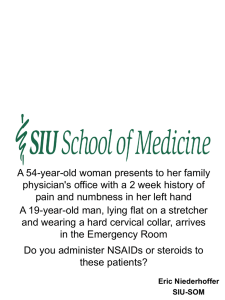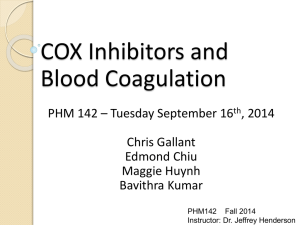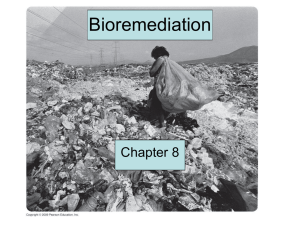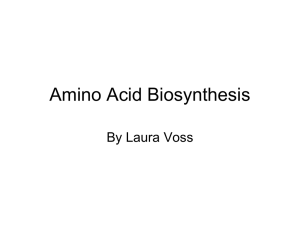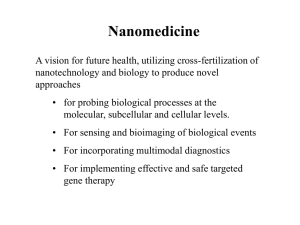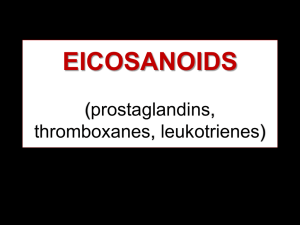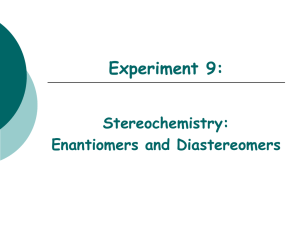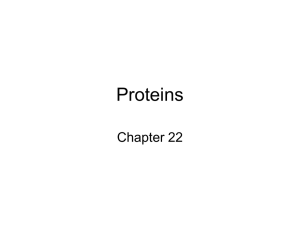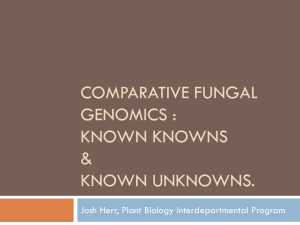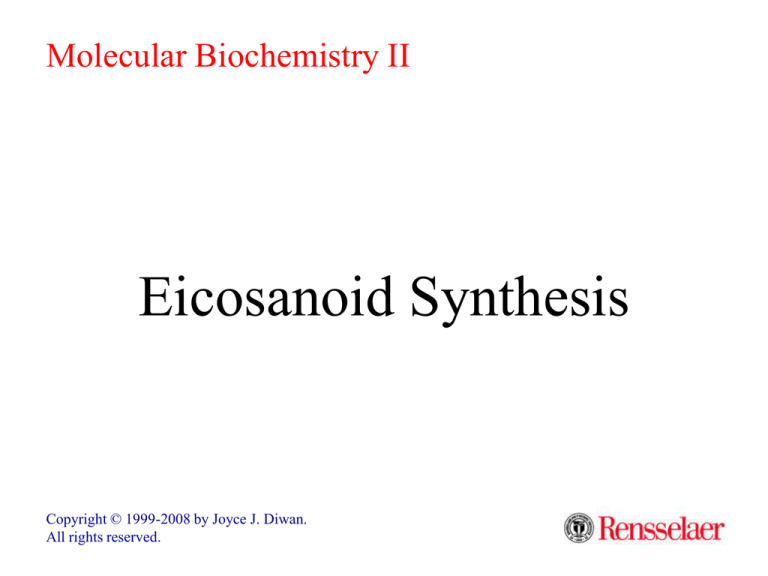
Molecular Biochemistry II
Eicosanoid Synthesis
Copyright © 1999-2008 by Joyce J. Diwan.
All rights reserved.
Prostaglandins and related compounds are collectively
known as eicosanoids.
Most are produced from arachidonic acid, a 20-carbon
polyunsaturated fatty acid (5,8,11,14-eicosatetraenoic acid).
The eicosanoids are considered "local hormones."
They have specific effects on target cells close to their
site of formation.
They are rapidly degraded, so they are not transported
to distal sites within the body.
But in addition to participating in intercellular signaling,
there is evidence for involvement of eicosanoids in
intracellular signal cascades.
Examples of eicosanoids:
prostaglandins
prostacyclins
thromboxanes
leukotrienes
epoxyeicosatrienoic acids.
They have roles in:
inflammation
fever
regulation of blood pressure
blood clotting
immune system modulation
control of reproductive processes & tissue growth
regulation of sleep/wake cycle.
O
COOH
PGE2
(prostaglandin E2)
is an example of a
prostaglandin,
produced from
arachidonic acid.
HO
OH
PGE2
COOH
Arachidonic acid
O
COOH
PGE2
(prostaglandin E2).
HO
OH
PGE2
Prostaglandins all have a cyclopentane ring.
A letter code is based on ring modifications (e.g.,
hydroxyl or keto groups).
A subscript refers to the number of double bonds in
the two side-chains.
Thromboxanes are similar but have instead a 6-member
ring.
Prostaglandin receptors:
Prostaglandins & related compounds are transported
out of the cells that synthesize them.
Most affect other cells by interacting with plasma
membrane G-protein coupled receptors.
Depending on the cell type, the activated G-protein
may stimulate or inhibit formation of cAMP, or may
activate a phosphatidylinositol signal pathway
leading to intracellular Ca++ release.
Another prostaglandin receptor, designated PPARg,
is related to a family of nuclear receptors with
transcription factor activity.
Prostaglandin receptors are specified by the same letter
code.
E.g., receptors for E-class prostaglandins are EP.
Thromboxane receptors are designated TP.
Multiple receptors for a prostaglandin are specified by
subscripts (E.g., EP1, EP2, EP3, etc.).
Different receptors for a particular prostaglandin may
activate different signal cascades.
Effects of a particular prostaglandin may vary in different
tissues, depending on which receptors are expressed.
E.g., in different cells PGE2 may activate either
stimulatory or inhibitory or G-proteins, leading to either
increase or decrease in cAMP formation.
The fatty acid
arachidonate
is often esterified
to OH on C2 of
glycerophospholipids, especially
phosphatidyl
inositol.
Site of cleavage by
Phospholipase A2
O
R2
C
O
O
H2C
O
C
C
H
O
CH2O
P
R1
H
OH
O
Site of cleavage by OH
Phospholipase C
H
OH
OH
H
OH
OH
H
H
Phosphatidyl inositol
Arachidonate is released from phospholipids by hydrolysis
catalyzed by Phospholipase A2.
This enzyme hydrolyzes the ester linkage between a fatty
acid and the OH at C2 of the glycerol backbone, releasing
the fatty acid & a lysophospholipid as products.
Corticosteroids are anti-inflammatory because they
prevent inducible Phospholipase A2 expression, reducing
arachidonate release.
There are multiple Phospholipase A2 enzymes, subject to
activation via different signal cascades.
The inflammatory signal platelet activating factor is
involved in activating some Phospholipase A2 variants.
Attempts have been made to develop drugs that inhibit
particular isoforms of Phospholipase A2, for treating
inflammatory diseases.
Success has been limited by the diversity of
Phospholipase A2 enzymes, and the fact that
arachidonate may give rise to inflammatory or
anti-inflammatory eicosanoids in different tissues.
O
O
R1
C
H2C
O
C
CH
H2C
Phosphatidyl
inositol signal
cascades may
lead to release
of arachidonate.
O
cleavage by
Phospholipase C
R2
O
O
P
O
O
H
OPO32
OH
H
OH
PIP2
OH
H
H
H
phosphatidylinositol4,5-bisphosphate
H
OPO32
After PI is phosphorylated to PIP2, cleavage via
Phospholipase C yields diacylglycerol (and IP3).
Arachidonate release from diacylglycerol is then
catalyzed by Diacylglycerol Lipase.
leukotrienes
Linear pathway Lipoxyganase
phospholipids
Two major
pathways of
eicosanoid
metabolism.
Cyclic
pathway:
arachidonate
diacylglycerol
Cyclic pathway PGH2 Synthase
Prostacyclin prostaglandin H2 Thromboxane
Synthase
Synthase
prostacyclins
thromboxanes
other prostaglandins
Prostaglandin H2 Synthase catalyzes the committed step
in the “cyclic pathway” that leads to production of
prostaglandins, prostacyclins, & thromboxanes.
Different cell types convert PGH2 to different compounds.
COOH
PGH2 Synthase is a
heme-containing
dioxygenase, bound
to ER membranes.
(A dioxygenase
incorporates O2 into
a substrate).
PGH2 Synthase
exhibits 2 activities:
cyclooxygenase &
peroxidase.
arachidonic acid
2 O2
Cyclooxygenase
O
COOH
O
PGG2
OOH
2 e
Peroxidase
O
COOH
O
PGH2
OH
COOH
PGH2 Synthase
(expressing both
cyclooxygenase &
peroxidase activities)
is sometimes referred
to as Cyclooxygenase,
abbreviated COX.
The interacting
cyclooxygenase and
peroxidase reaction
pathways are complex.
arachidonic acid
2 O2
Cyclooxygenase
O
COOH
O
PGG2
OOH
2 e
Peroxidase
O
COOH
O
PGH2
OH
A peroxide (such as that
generated later in the
reaction sequence)
oxidizes the heme iron.
The oxidized heme
accepts an electron from
a nearby tyrosine
residue (Tyr385).
The resulting tyrosine
radical is proposed to
extract a H atom from
arachidonate, generating
a radical species that
reacts with O2.
COOH
arachidonic acid
2 O2
Cyclooxygenase
O
COOH
O
PGG2
OOH
2 e
Peroxidase
O
COOH
O
PGH2
OH
The signal molecule ·NO (nitric oxide) may
initiate prostaglandin synthesis by reacting with
superoxide anion (O2·) to produce peroxynitrite,
which oxidizes the heme iron enabling electron
transfer from the active site tyrosine.
Prostaglandin synthesis in response to some
inflammatory stimuli is diminished by inhibitors
of Nitric Oxide Synthase.
PDB 1PGE
Membranebinding
domain:
heme
4 short
amphipathic
ibuprofen
a-helices that analog
insert into one
membrane
leaflet of the
bilayer, facing binding
domain
Prostaglandin H2 Synthase
the ER lumen.
Arachidonate, derived from membrane lipids, approaches
the heme via a hydrophobic channel extending from the
membrane-binding domain.
In the image above, the channel is occupied by an
inhibitor, an ibuprofen analog.
Non-steroidal anti-inflammatory drugs
(NSAIDs), such as aspirin and derivatives
of ibuprofen, inhibit cyclooxygenase
activity of PGH2 Synthase.
H3C
CH3
CH
CH2
They inhibit formation of prostaglandins
involved in fever, pain, & inflammation.
They inhibit blood clotting by
blocking thromboxane formation
in blood platelets.
Ibuprofen and related compounds block the
hydrophobic channel by which arachidonate
enters the cyclooxygenase active site.
CH
H3C
COOH
Ibuprofen
O
COOH
O
C
CH3
Aspirin
+
Enz-Ser
CH2
OH
PGH2 Synthase (active)
COOH
O
OH
+
Salicylic acid
Enz-Ser
CH2 O
C
CH3
Acetylated PGH2 Synthase (inactive)
Aspirin acetylates a serine hydroxyl group near the active
site, preventing arachidonate binding.
The inhibition by aspirin is irreversible.
However, in most body cells re-synthesis of PGH2 Synthase
would restore cyclooxygenase activity.
Thromboxane A2 stimulates blood platelet aggregation,
essential to the role of platelets in blood clotting.
Many people take a daily aspirin for its anti-clotting
effect, attributed to inhibition of thromboxane
formation in blood platelets.
This effect of aspirin is long-lived because platelets
lack a nucleus and do not make new enzyme.
Two isoforms of PGH2 Synthase: COX-1 & COX-2
(Cyclooxygenase 1 & 2):
COX-1 is constitutively expressed at low levels in
many cell types.
COX-2 expression is highly regulated.
Transcription of the gene for COX-2 is stimulated by
growth factors, cytokines, and endotoxins.
COX-2 expression may be enhanced by cAMP, and
in many cells PGE2 produced as a result of COX-2
activity itself leads to changes in cAMP levels.
Both catalyze PGH2 formation, but differing localization
within a cell, & localization of enzymes that convert PGH2
into particular prostaglandins/ thromboxanes, may result in
COX-1 & COX-2 yielding different ultimate products.
COX-1 is essential for thromboxane formation in
blood platelets, and for maintaining integrity of the
gastrointestinal epithelium.
COX-2 levels increase in inflammatory diseases such
as arthritis.
Inflammation is associated with up-regulation of
COX-2 & increased amounts of particular prostaglandins.
COX-2 expression is increased in some cancer cells.
Angiogenesis (blood vessel development), which is
essential to tumor growth, requires COX-2.
Overexpression of COX-2 leads to increased expression
of VEGF (vascular endothelial growth factor).
Regular use of NSAIDs has been shown to decrease the
risk of developing colorectal cancer.
Most NSAIDs inhibit both COX I & COX II.
Selective COX-2 inhibitors have been developed, e.g.,
Celebrex and Vioxx.
COX-2 inhibitors are anti-inflammatory & block pain,
but are less likely to cause gastric toxicity associated
with chronic use of NSAIDs that block COX-1.
A tendency to develop blood clots when taking some
of these drugs has been attributed to:
• decreased production of an anti-thrombotic (clot
blocking) prostaglandin (PGI2) by endothelial cells
lining small blood vessels
• lack of inhibition of COX-1-mediated formation
of pro-thrombotic thromboxanes in platelets.
Some evidence suggests the existence of a third
isoform of PGH2 Synthase, designated COX-3, with
roles in mediating pain and fever, and subject to
inhibition by acetaminophen (Tylenol).
Acetaminophen has little effect on COX-1 or COX-2,
and thus lacks anti-inflammatory activity.
Explore the structure of PGH2 Synthase-1 (COX-1)
crystallized with bound iodosuprofen, a derivative of
ibuprofen.
leukotrienes
Linear pathway Lipoxyganase
phospholipids
arachidonate
diacylglycerol
Cyclic pathway PGH2 Synthase
Prostacyclin prostaglandin H2 Thromboxane
Synthase
Synthase
prostacyclins
thromboxanes
other prostaglandins
The 1st step of the Linear Pathway for synthesis of
leukotrienes is catalyzed by Lipoxygenase.
Mammals have a family of Lipoxygenase enzymes that
catalyze oxygenation of various polyunsaturated fatty acid
at different sites. Many of the products have signal roles.
Catalyzed by 5-Lipoxygenase:
COOH
E.g., 5-Lipoxygenase,
found in leukocytes,
catalyzes conversion
of arachidonate to
5-HPETE
(5-hydroperoxyeicosatetraenoic acid).
5-HPETE is converted
to leukotriene-A4,
which in turn may be
converted to various
other leukotrienes.
arachidonate
O2
OOH
COOH
5-HPETE
H2O
O
COOH
leukotriene-A4
A non-heme iron is the
prosthetic group of
Lipoxygenase enzymes.
membranebinding
domain
Ligands to the Fe include
3 His N atoms & the
C-terminal carboxylate O.
substrate
analog
adjacent to
Fe (green)
The arachidonate substrate
binds in a hydrophobic
pocket, adjacent to the
catalytic iron atom.
O2 is thought to approach
from the opposite side of
the substrate than the iron,
for a stereospecific reaction.
15-Lipoxygenase
PDB 1LOX
COOH
Lipoxygenase reaction
starts with extraction of
H from arachidonate,
with transfer of the e to
the iron, reducing it from
Fe3+ Fe2+.
The resulting fatty acid
radical reacts with O2 to
form a hydroperoxy group.
arachidonate
O2
OOH
COOH
5-HPETE
Which H is extracted, & the position of the hydroperoxy
group, varies with different lipoxygenases (e.g.,
5-Lipoxgenase shown here, 15-Lipoxygenase, etc.)
Additional reactions then yield the various leukotrienes.
Leukotrienes have roles in inflammation.
They are produced in areas of inflammation in blood
vessel walls as part of the pathology of atherosclerosis.
Leukotrienes are also implicated in asthmatic constriction
of the bronchioles.
Some leukotrienes act via specific G-protein coupled
receptors (GPCRs) in the plasma membrane.
Anti-asthma medications include:
inhibitors of 5-Lipoxygenase, e.g., Zyflo (zileuton)
drugs that block leukotriene-receptor interactions.
E.g., Singulair (montelukast) & Accolate (zafirlukast)
block binding of leukotrienes to their receptors on the
plasma membranes of airway smooth muscle cells.
5-Lipoxygenase requires the membrane protein FLAP
(5-lipoxygenase-activating protein).
FLAP binds arachidonate, facilitating its interaction
with the enzyme.
Translocation of 5-Lipoxygenase from the cytoplasm
to the nucleus, and formation of a complex including
5-Lipoxygenase, FLAP, & Phospholipase A2 in
association with the nuclear envelope has been
observed during activation of leukotriene synthesis in
leukocytes.
membranebinding
domain
A b-barrel domain at
the N-terminus of
Lipoxygenase enzymes
may have a role in
membrane binding.
substrate
analog
adjacent to
Fe (green)
Explore the structure of
Lipoxygenase, with a
substrate analog present at
the active site.
15-Lipoxygenase
PDB 1LOX
COOH
COOH
O
Arachidonic acid
14,15-EET
Cytochrome P450 epoxygenase pathways:
Epoxyeicosatrienoic acids (EETs) and
hydroxyeicosatrienoic acids are formed from
arachidonate by enzymes of the cytochrome P450 family.
Other members of the cytochrome P450 family participate
in a variety of oxygenation reactions, including
hydroxylation of sterols.
Shown is an EET
produced from
arachidonate by activity
of a cytochrome
P450 epoxygenase.
COOH
O
14,15-EET
(14,15-epoxyeicosatrienoic acid)
EETs are modified by additional enzyme-catalyzed
reactions to produce many distinct compounds.
They may be incorporated into phospholipids, and
released by action of phospholipases.
EETs have roles in regulating cellular proliferation,
inflammation, peptide hormone secretion, & various signal
pathways relevant to cardiovascular and renal functions.
E.g., EETs inhibit apoptosis in endothelial cells.

